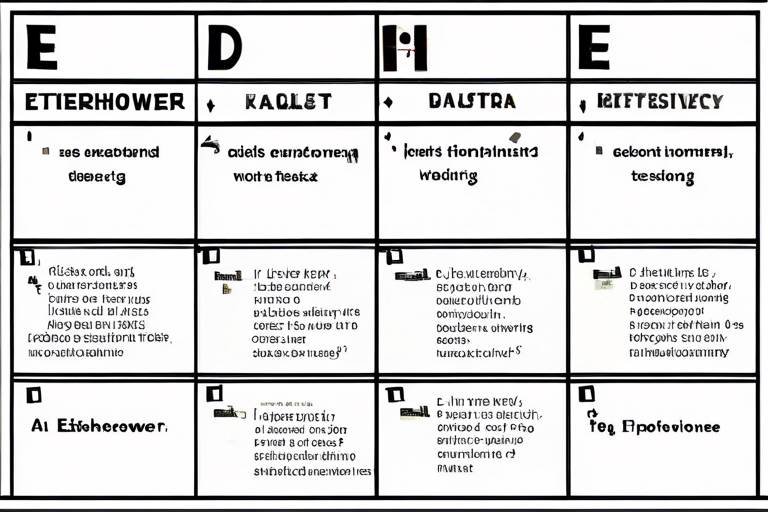The Eisenhower Matrix - Prioritizing Tasks Effectively
The Eisenhower Matrix, also known as the Urgent-Important Matrix, is a powerful tool for prioritizing tasks and managing time effectively. This method, popularized by President Dwight D. Eisenhower, helps individuals categorize tasks based on their urgency and importance, allowing them to focus on what truly matters.

Understanding the Eisenhower Matrix
The Eisenhower Matrix, also known as the Urgent-Important Matrix, is a powerful tool that helps individuals prioritize tasks effectively by categorizing them based on their level of urgency and importance. Developed by former U.S. President Dwight D. Eisenhower, this matrix provides a clear framework for decision-making and time management.
At the core of the Eisenhower Matrix are two key criteria: urgency and importance. Tasks are classified into four quadrants based on these criteria, guiding individuals on where to focus their time and energy for maximum productivity and goal achievement.
Understanding the Eisenhower Matrix involves grasping the concept that not all tasks are created equal. Some tasks may seem urgent but lack true importance, while others may be important but not necessarily urgent. By categorizing tasks into different quadrants, individuals can gain clarity on what truly matters and avoid getting caught up in the busyness of day-to-day activities.
Quadrant 1 consists of tasks that are both urgent and important, requiring immediate attention. These tasks are often crisis-driven and demand immediate action to prevent negative consequences. Examples include deadlines, emergencies, and pressing issues that cannot be postponed.
On the other hand, Quadrant 2 comprises tasks that are important but not urgent. These tasks contribute to long-term goals, personal growth, and strategic planning. While they may not have immediate deadlines, focusing on Quadrant 2 tasks is crucial for sustainable success and overall well-being.
By understanding the Eisenhower Matrix, individuals can gain a holistic view of their tasks and responsibilities, enabling them to make informed decisions about where to allocate their time and resources. This strategic approach to task management can lead to increased productivity, reduced stress, and improved overall effectiveness in achieving desired outcomes.

Quadrant 1: Urgent and Important Tasks
Quadrant 1 in the Eisenhower Matrix is where tasks that are both urgent and important are placed. These tasks demand immediate attention and action as they have a direct impact on your goals and objectives. When a task falls into Quadrant 1, it signifies that it requires immediate action to prevent negative consequences or missed opportunities. These tasks are often deadline-driven and cannot be ignored without significant repercussions.

Dealing with Quadrant 1 Tasks
When it comes to dealing with Quadrant 1 tasks in the Eisenhower Matrix, it's crucial to adopt a proactive approach to ensure that urgent and important tasks are handled efficiently. One effective strategy is to set clear deadlines for each task, creating a sense of urgency and accountability. By establishing specific timelines, you can prioritize tasks based on their level of importance and avoid the trap of procrastination that often accompanies high-pressure tasks.
Additionally, it's essential to assess the impact of each Quadrant 1 task on your overall goals and objectives. By understanding how each task contributes to your long-term success, you can allocate resources and attention accordingly, focusing on the tasks that align most closely with your priorities. This strategic approach not only increases productivity but also ensures that you are making progress towards your ultimate objectives.
In some cases, delegation can be a valuable tool for managing Quadrant 1 tasks effectively. By entrusting certain responsibilities to others who are capable of handling them, you free up time and mental energy to concentrate on tasks that require your unique skills and expertise. Delegating tasks that do not require your direct involvement can help streamline your workflow and prevent overwhelm, allowing you to maintain a clear focus on high-priority activities.

Quadrant 2: Important but Not Urgent Tasks
Quadrant 2 in the Eisenhower Matrix is where tasks that are important but not urgent are categorized. These tasks may not require immediate attention, but they play a crucial role in long-term success and goal achievement. By focusing on Quadrant 2 tasks, individuals can proactively work towards their objectives and prevent last-minute stress and rush.

Benefits of Quadrant 2 Focus
When focusing on Quadrant 2 tasks in the Eisenhower Matrix, you are investing your time and energy in activities that are important for your long-term goals and objectives. By dedicating attention to these tasks, you are essentially planting seeds that will grow and yield significant results in the future. It's like tending to a garden, where nurturing the right plants leads to a bountiful harvest.

Quadrant 3: Urgent but Not Important Tasks
Quadrant 3 in the Eisenhower Matrix represents tasks that are urgent but not important. These tasks often give the illusion of importance due to their urgency, but they do not contribute significantly to your long-term goals or priorities. It's crucial to differentiate between tasks that truly matter and those that only seem urgent in the moment.
Identifying Quadrant 3 tasks is essential to avoid getting caught up in activities that do not align with your objectives. By recognizing these tasks, you can minimize distractions and focus your energy on activities that have a meaningful impact on your overall productivity and success.
One strategy for handling Quadrant 3 tasks is delegation. By assigning these tasks to others who are better suited to complete them, you can free up your time for more important activities. Setting boundaries is also key in managing Quadrant 3 tasks effectively. Learn to say no to tasks that do not align with your priorities, allowing you to maintain focus on what truly matters.

Avoiding Quadrant 3 Pitfalls
Avoiding Quadrant 3 Pitfalls involves recognizing tasks that may seem urgent but are not truly important in the grand scheme of your goals and priorities. It's crucial to differentiate between tasks that offer real value and those that simply demand immediate attention. By mastering this skill, you can steer clear of distractions that hinder your progress and focus on activities that align with your long-term objectives.
Frequently Asked Questions
- What is the Eisenhower Matrix?
The Eisenhower Matrix is a productivity tool that helps individuals prioritize tasks based on their urgency and importance. It is named after President Dwight D. Eisenhower and consists of four quadrants to categorize tasks effectively.
- How can the Eisenhower Matrix benefit me?
The Eisenhower Matrix can benefit you by providing a clear framework for organizing tasks, enabling you to focus on what truly matters, increase productivity, reduce stress, and achieve long-term goals effectively.
- What are Quadrant 1 tasks?
Quadrant 1 tasks are both urgent and important, requiring immediate attention and action. These tasks are critical and have a direct impact on your goals and objectives.
- How should I handle Quadrant 3 tasks?
To handle Quadrant 3 tasks effectively, consider strategies such as delegation, setting boundaries, and learning to say no to tasks that do not align with your priorities. Minimizing Quadrant 3 tasks can prevent distractions and improve productivity.

















